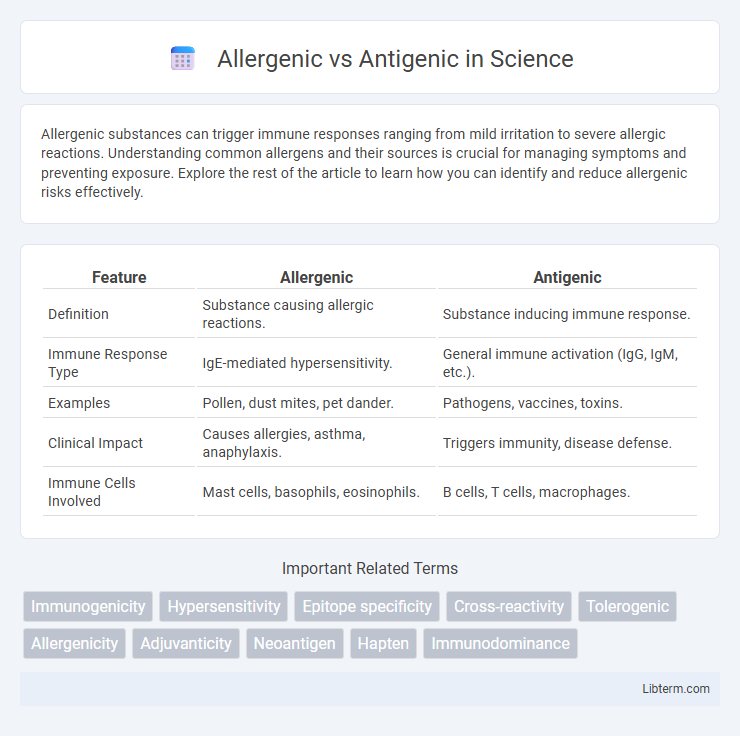Allergenic substances can trigger immune responses ranging from mild irritation to severe allergic reactions. Understanding common allergens and their sources is crucial for managing symptoms and preventing exposure. Explore the rest of the article to learn how you can identify and reduce allergenic risks effectively.
Table of Comparison
| Feature | Allergenic | Antigenic |
|---|---|---|
| Definition | Substance causing allergic reactions. | Substance inducing immune response. |
| Immune Response Type | IgE-mediated hypersensitivity. | General immune activation (IgG, IgM, etc.). |
| Examples | Pollen, dust mites, pet dander. | Pathogens, vaccines, toxins. |
| Clinical Impact | Causes allergies, asthma, anaphylaxis. | Triggers immunity, disease defense. |
| Immune Cells Involved | Mast cells, basophils, eosinophils. | B cells, T cells, macrophages. |
Understanding Allergenic and Antigenic: Basic Definitions
Allergenic refers to a substance that triggers an allergic reaction by stimulating an immune response, often involving the production of IgE antibodies. Antigenic describes the ability of a substance, called an antigen, to bind specifically with immune components such as antibodies or T-cell receptors, initiating an immune response that may or may not cause allergies. Understanding the difference between allergenic and antigenic properties is crucial for immunology, vaccine development, and allergy diagnostics.
Key Differences Between Allergens and Antigens
Allergens trigger hypersensitive immune responses causing allergic reactions, while antigens are any substances recognized by the immune system that induce antibody production. Allergens are typically harmless environmental proteins like pollen or dust mites, whereas antigens include pathogens such as bacteria and viruses. The key difference lies in allergens causing exaggerated immune reactions, whereas antigens elicit a normal protective immune response.
How Allergens Trigger Immune Responses
Allergens are specific types of antigens that uniquely trigger allergic immune responses by activating IgE antibodies, leading to histamine release and inflammation. Unlike general antigens, allergens provoke hypersensitivity reactions involving mast cells and basophils, which result in symptoms such as itching, swelling, and respiratory distress. Understanding the molecular structure of allergens helps in identifying epitopes that bind IgE, facilitating targeted allergy diagnostics and immunotherapy approaches.
Antigens: The Body’s Targets for Immunity
Antigens are specific molecules or molecular structures, such as proteins or polysaccharides, recognized by the immune system as foreign, triggering immune responses. These targets stimulate the production of antibodies and activate immune cells to protect the body from pathogens like bacteria, viruses, and toxins. Unlike allergens, which cause hypersensitive reactions, antigens encompass a broader category that includes all substances capable of eliciting an immune defense, making them central to immunological recognition and response.
Common Sources of Allergens and Antigens
Common sources of allergens include pollen, pet dander, dust mites, and certain foods such as nuts and shellfish, which trigger hypersensitive immune responses in susceptible individuals. Antigens, found in bacteria, viruses, and foreign proteins, stimulate the immune system to produce antibodies, serving as critical components in immune defense mechanisms. Understanding the distinction between allergenic substances and antigenic molecules underpins the development of targeted allergy treatments and vaccines.
Allergic Reactions: Mechanisms and Symptoms
Allergenic substances trigger allergic reactions by stimulating the immune system to produce Immunoglobulin E (IgE) antibodies, which bind to mast cells and basophils, causing the release of histamine and other inflammatory mediators. Antigens, while capable of eliciting an immune response, do not necessarily induce IgE production or allergic symptoms unless they function as allergens. Symptoms of allergic reactions include itching, swelling, redness, sneezing, and in severe cases, anaphylaxis, all resulting from the hypersensitivity characterized by allergenic recognition and immune system overactivation.
Antigenic Determinants and Immune Recognition
Antigenic determinants, also known as epitopes, are specific molecular regions on an antigen that are recognized by immune receptors, triggering an immune response. Antigenicity refers to the ability of a substance to bind specifically to antibodies or T-cell receptors, whereas allergenicity describes the capacity to induce an allergic reaction, often involving IgE antibodies. The precise interaction between antigenic determinants and immune cells enables immune recognition, distinguishing between harmless and harmful substances to initiate appropriate immune mechanisms.
Clinical Significance: Allergy vs Immune Defense
Allergenic substances trigger hypersensitive immune responses causing allergic reactions such as rhinitis, asthma, or anaphylaxis, significantly impacting patient quality of life and requiring targeted treatments like antihistamines or immunotherapy. Antigenic properties stimulate the immune system to produce a defensive response against pathogens, essential for vaccine efficacy and pathogen clearance without causing allergic symptoms. Understanding the clinical significance differentiates allergens as harmful triggers in susceptible individuals, whereas antigens serve as critical components for immune defense and immunological memory formation.
Diagnostic Approaches: Identifying Allergens and Antigens
Diagnostic approaches for distinguishing allergenic from antigenic substances primarily involve immunoassays such as enzyme-linked immunosorbent assays (ELISA) and skin prick tests, which detect specific IgE antibodies indicative of allergenic responses. Molecular techniques like immunoblotting and mass spectrometry further characterize protein epitopes to differentiate allergenic proteins from other antigens. Advanced methods, including flow cytometry and basophil activation tests, enhance the specificity and sensitivity in identifying allergen-specific immune reactions for clinical diagnostics.
Therapeutic Strategies: Managing Allergenic and Antigenic Responses
Therapeutic strategies for managing allergenic responses involve the use of antihistamines, corticosteroids, and immunotherapy to reduce hypersensitivity and prevent severe allergic reactions. In contrast, approaches targeting antigenic responses focus on enhancing immune tolerance through vaccines, monoclonal antibodies, and immune checkpoint inhibitors to treat infections or autoimmune diseases. Precision medicine techniques, including biomarker identification and personalized treatment plans, optimize the efficacy and safety of therapies addressing both allergenic and antigenic challenges.
Allergenic Infographic

 libterm.com
libterm.com